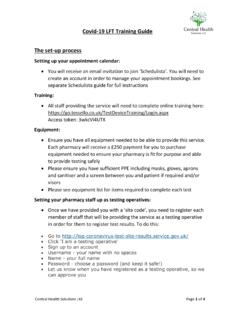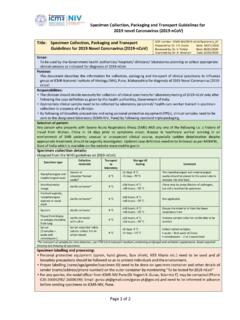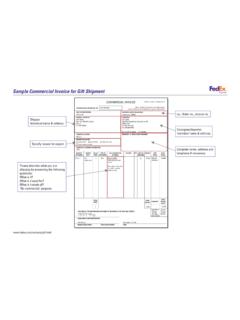Transcription of Guidelines for the Safe Transport of Infectious Substances ...
1 WORLD HEALTH ORGANIZATIOND ivision of Emerging and Other CommunicableDiseases Surveillance and ControlGuidelines forthe Safe Transport ofInfectious Substancesand Diagnostic SpecimensWHO/ : GeneralOrig.: English World Health Organization, 1997 This document is not a formal publication of theWorld Health Organization (WHO), and all rights are reservedby the Organization. The document may, however, be freely reviewed,abstracted, reproduced and translated, in part or in whole,but not for sale nor for use in conjunction with commercial document was prepared by the Directorsof WHO Collaborating Centres for Biosafety and other of ContentsIntroduction.
2 1 Definitions .. 2 Infectious Substances .. 2 Diagnostic Specimens .. 2 Packaging, Labelling and Documentation for Transport .. 3 Basic Triple Packaging System .. 3 Requirements for Infectious Substances .. 5 Requirements for Diagnostic Specimens .. 9 Requirements for Air Mail .. 10 Refrigerants .. 10 Local Surface Transport .. 11 Transport Planning .. 12i1 WHO/ Transport of Infectious SubstancesIntroductionThese Guidelines are applicable to the Transport of Infectious Substances anddiagnostic specimens both nationally and internationally.
3 They provideinformation for identifying and classifying the material to be transported andfor its safe packaging and Transport . The Guidelines stress the importance ofdeveloping a working relationship between the groups involved the sender,the carrier and the receiver in order to provide for the safe and expeditioustransport of this , airline and other Transport industry personnel hold concerns about thepossibility of their becoming infected as the result of exposure to infectiousmicroorganisms that may escape from broken, leaking or improperly packagedmaterial.
4 The packaging of Infectious materials for Transport must thereforeaddress these concerns and be designed to minimise the potential for damageduring Transport . In addition, the packaging will serve to ensure the integrity ofthe materials and timely processing of are no recorded cases of illness attributable to the release of specimensduring Transport , although there are reported incidents of damage to the outerpackaging of properly packaged materials. The shipment of unmarked andunidentified Infectious materials, improperly packaged, obviously increases theoverall potential for exposure to all international regulations for the Transport of Infectious materials by anymode of Transport are based upon the Recommendations of the United NationsCommittee of Experts on the Transport of Dangerous Goods (UN).
5 The UniversalPostal Union (UPU) reflects these recommendations in its regulations,particularly for packaging. The International Civil Aviation Organization (ICAO)and the International Air Transport Association (IATA) have also incorporatedthe UN Recommendations in their respective regulations, as have otherinternational Transport organizations. The World Health Organization servesin an advisory capacity to these bodies. This document provides practicalguidance to facilitate compliance with current international regulations.
6 If, at afuture date, any modification is made in the section of the UN Recommendationson the Transport of Dangerous Goods dealing with Infectious Substances anddiagnostic specimens, these Guidelines will be updated Transport of Infectious Substances2 DefinitionsFor the purpose of describing Transport safety measures the terms infectioussubstances and Infectious materials are considered synonymous. The term Infectious Substances will be used in this substancesAn Infectious substance is defined as a substance containing a viablemicroorganism, such as a bacterium, virus, rickettsia, parasite or fungus, that isknown or reasonably believed to cause disease in humans or animals*.
7 With respect to packaging and Transport situations, Infectious Substances include:1. all cultures containing or suspected of containing an agent which may causeinfection;2. human or animal samples that contain such an agent in quantities sufficientto cause infection, should an exposure to them occur due to a transportmishap;3. sample(s) from a patient with a serious disease of unknown cause;4. other specimens not included above and designated as Infectious by aqualified person, a physician, scientist, nurse, etc.*This definition is taken from the current UN Recommendations on theTransport of Dangerous Goods.
8 Prions are not included in this definitionalthough they are considered to be Infectious specimensA diagnostic specimen is defined as any human or animal material including,but not limited to, excreta, blood and its components, tissue and tissue fluidscollected for the purposes of diagnosis, but excluding live infected specimens resulting from medical practice and research are considered anegligible threat to the public Transport of Infectious SubstancesDiagnostic specimens obtained from patients with suspected Infectious diseasesmay contain limited quantities of an Infectious agent.
9 There are very few agentswhich may be the source of an infection as a result of a Transport mishap. Ifexposure to the specimen due to Transport mishap could result in an infection, thediagnostic specimen must be packaged, labelled and transported as an infectioussubstance. Diagnostic specimens collected during an investigation of an outbreakof a serious disease of unknown cause must be handled as Infectious , Labelling andDocumentation for TransportBecause of the distinction of risks between Infectious Substances and diagnosticspecimens, there are variations to the packaging, labelling and documentationrequirements.
10 The packaging requirements are determined by the UN and arecontained in ICAO and IATA regulations in the form of Packaging Instructions(PI) 602 and 650. The requirements are subject to change and upgrade by theseorganisations. The current packaging requirements are described below. UN-approved packaging systems are available triple packaging systemThe system consists of three layers as Primary receptacle. A labelled primary watertight, leak-proof receptaclecontaining the specimen. The receptacle is wrapped in enough absorbentmaterial to absorb all fluid in case of Secondary receptacle.














